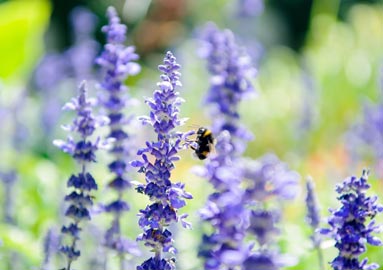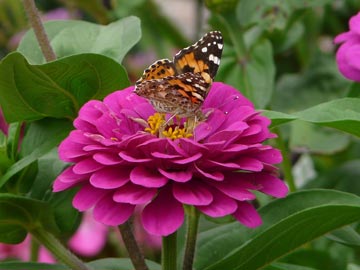Some of the best plants for attracting and supporting bees, butterflies and other pollinators are annuals. Annuals are the least expensive plants in the garden center, and most are easy to grow from seed. Summer annuals earn their keep because of their flower power, and low maintenance.
Salvias
 Brightly colored salvia flowers attract bees, butterflies, and goldfinches.
Brightly colored salvia flowers attract bees, butterflies, and goldfinches.
iStock/Thinkstock
Ornamental salvias are commonly called sage and yes, they are in the same family as the sage of Thanksgiving fame.
- Mealy cup sage, has stalks of blue, white or bi-color flowers that bees, butterflies and goldfinches love. These prefer a hot, sunny location, but tolerate areas with four to six hours of sun or daylong filtered sun. These are good selections for getting height in summer pots.Look for: Victoria Blue, Victoria White, Indigo Spires, Evolution or Blue Frost.
- Scarlet sage has tubular flowers that hummingbirds regularly visit. Reds, peach, salmon, mauve or lavender flowers grow outward from stalks. Grow in full sun. Good ones are Lady in Red, or those in the Jewel, Lighthouse or Vista series.
- Hummingbird sage has gained a lot of popularity. While it is technically a perennial, it acts as annual above Zone 7. Varieties include Black and Blue and Black & Bloom.
Petunias
 Trumpet-shaped petunias will invite bees and hummingbirds to your yard.
Trumpet-shaped petunias will invite bees and hummingbirds to your yard.
iStock/Thinkstock
Petunias can cover the ground or dangle from pots for months in summer. Trumpet-shaped flowers invite hummingbirds and bees to taste the nectar. Some, such as the Madness series and Royal Velvet, are fragrant.
Petunias come in dozens of colors and are readily available at garden centers. They also can be grown from seed. Grow petunias in full sun or part shade.
Petunias in pots benefit from a midsummer redo. Cut them back by half to three-quarters and give them a good dose of an all purpose plant food, according to label directions. This may sound extreme, but the petunias will love it and you will, too, as they start growing in a week or two. They will be full, lush and full of flowers.
Zinnias
 Zinnias are a favorite for attracting bees and butterflies throughout the summer.
Zinnias are a favorite for attracting bees and butterflies throughout the summer.
Pixabay
Butterflies and bees love zinnias. They visit frequently, taking in a nectar meal or two and soaking up the sun’s rays.
Transplants can be found in garden centers, or zinnias are easy to grow from seed sown directly outdoors in late spring and early summer. Grow zinnias in full sun, where they get six to eight hours of direct sun a day.
Some varieties, such as the Profusion series, are resistant to powdery mildew, a common zinnia disease. Don’t worry though, the disease, which is cosmetic and doesn’t affect the flowers or pollinators. State Fair Mix, Blue Point Bouquet and Cut-and-Come Again are just a few favorites for cut flowers.
Tips:
- An annual’s goal is to bloom and set seed in a season. The trick to keep them producing flowers is to snip off blooms when they’re spent.
- Make sure annuals get adequate moisture.
- Apply an all purpose plant food according to label directions.
- Cut a few for indoor bouquets.
By Jo Ellen Meyers Sharp